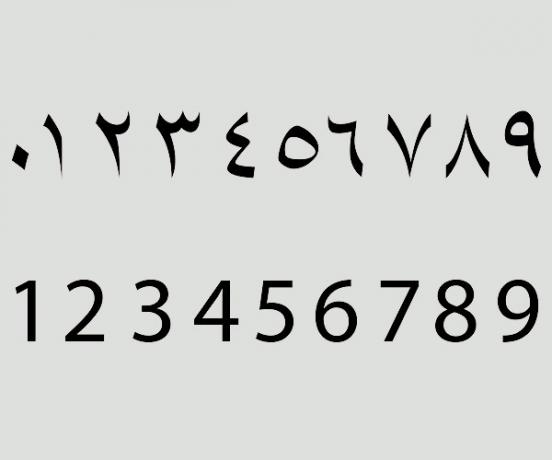Arabic numerals, also called Indo-Arabic numerals, are the components of the numbering system currently used to represent numbers. Thus, the digit is a symbol used to make a numerical representation.
Arabic numerals are ten and are used to form all other numbers.
| 0 | 1 | 2 | 3 | 4 | 5 | 6 | 7 | 8 | 9 |
For example: the number 1286 consists of four different digits.
How did Arabic numerals come about?
The exact origin of the Arabic numerals is uncertain. However, the most considerable explanation for the rise of these numbers is linked to the history of India.
This numbering system would have been developed by the Hindus, then spreading to the Islamic world and later to the rest of the world. The creation of figures by the Hindu people, according to historical records, took place approximately 300 years before Christ.
During this period, the numbers 1 to 9 appeared. The introduction of the number 0 happened later, when the system evolved. The appearance of 0 dates back almost 870 years after Christ, approximately 1200 years after the appearance of the first numbers.
Arabic numerals diffusion
The person responsible for the dissemination of the Indo-Arabic system throughout the European continent was the Italian mathematician Leonardo Fibonacci (1170 - 1250). The emergence of Arabic numerals is very important in the development of the world, being one of the most relevant progress in the history of mathematics.
When Fibonacci wrote the book Liber Abacci, on arithmetic, he introduced Arabic numerals for the whole of Europe. The work is recognized worldwide for being the first record of a book that introduced and explained the workings of this numbering system, which was previously unknown. At the time, the mathematician presented the system calling itself hindu method.
Modification of Arabic numerals
The Indo-Arabic numerals changed over time, until they acquired the shapes they have today.
See the image below for a comparison between how Arabic numeral symbols were drawn when they were created and how they are used today. Note that the traits have changed a great deal since the time of their appearance.
Over time, the numerical system was modified and simplified, until it reached the format used today.

What is the explanation for the design of Arabic numbers?
By observing the initial forms of the figures, it is possible to see that their drawings faithfully corresponded to the number of angles that each of the symbols had.
Thus, according to the initial image of the symbol, each digit was represented by the exact number of angles it had.
See in the image:

Also read the meaning of Number.
Differences between Arabic and Roman numerals
Roman numbers are another form of numerical representation that emerged at the time of the Roman Empire, more precisely in Ancient Rome.
To represent the Roman numerals the system uses seven letters which, according to the combination made, form the numbers. The seven letters correspond to the following values:
I = 1
V = 5
X = 10
L = 50
C = 100
D = 500
M = 1000
See in this table how the roman numbers from 1 to 100 are written.
| I | 1 |
| II | 2 |
| III | 3 |
| IV | 4 |
| V | 5 |
| SAW | 6 |
| VII | 7 |
| VIII | 8 |
| IX | 9 |
| X | 10 |
| XI | 11 |
| XII | 12 |
| XIII | 13 |
| XIV | 14 |
| XV | 15 |
| XVI | 16 |
| XVII | 17 |
| XVIII | 18 |
| XIX | 19 |
| XX | 20 |
| XXX | 30 |
| XL | 40 |
| L | 50 |
| LX | 60 |
| LXX | 70 |
| LXXX | 80 |
| XC | 90 |
| Ç | 100 |
To learn more about this system see the article Roman numbers.
